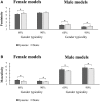Motion and Gender-Typing Features Interact in the Perception of Human Bodies
- PMID: 32372898
- PMCID: PMC7186348
- DOI: 10.3389/fnins.2020.00277
Motion and Gender-Typing Features Interact in the Perception of Human Bodies
Abstract
The human body conveys socially relevant information, including a person's gender. Several studies have shown that both shape and motion inform gender judgments of bodies. However, while body shape seems to influence more the judgment of female bodies, body motion seems to play a major role in the judgments of male bodies. Yet, the interdependence of morphologic and dynamic cues in shaping gender judgment and attractiveness evaluation in body perception is still unclear. In two experiments, we investigated how variations of implied motion and shape interact in perceptual and affective judgments of female and male bodies. In Experiment 1, participants were asked to provide ratings for masculinity and femininity of virtual renderings of human bodies with variable gender-typing features and implied motion. We found evidence of a tendency to perceive bodies in static poses as more feminine and bodies in dynamic poses as more masculine. In Experiment 2, participants rated the same pictures for dynamism and pleasantness. We found that male bodies were judged more dynamic than female bodies with the same pose. Also, female bodies were liked more in static than in dynamic poses. A mediation analysis allowed us to further shed light on the relationship between gender-typing features and motion, suggesting that the less is the movement conveyed by a female body, the greater is an observer's sensitivity to its femininity, and this leads to a more positive evaluation of its pleasantness. Our findings hint to an association between stillness and femininity in body perception, which can stem from either the evolutionary meaning of sexual selection and/or the influence of cultural norms.
Keywords: attractiveness; body aesthetic; body image; gender bias; gender perception; implied motion; sex categorization.
Copyright © 2020 D’Argenio, Finisguerra and Urgesi.
Figures





Similar articles
-
"What women like": influence of motion and form on esthetic body perception.Front Psychol. 2012 Jul 9;3:235. doi: 10.3389/fpsyg.2012.00235. eCollection 2012. Front Psychol. 2012. PMID: 22866044 Free PMC article.
-
Functional specificity and neural integration in the aesthetic appreciation of artworks with implied motion.Eur J Neurosci. 2021 Nov;54(9):7231-7259. doi: 10.1111/ejn.15479. Epub 2021 Oct 26. Eur J Neurosci. 2021. PMID: 34585450
-
Sex typing and the perception of body outlines.J Pers. 1983 Dec;51(4):667-82. doi: 10.1111/j.1467-6494.1983.tb00873.x. J Pers. 1983. PMID: 6668535
-
Chemosensory Communication of Gender Information: Masculinity Bias in Body Odor Perception and Femininity Bias Introduced by Chemosignals During Social Perception.Front Psychol. 2016 Jan 20;6:1980. doi: 10.3389/fpsyg.2015.01980. eCollection 2015. Front Psychol. 2016. PMID: 26834656 Free PMC article.
-
Gender identity and its implications for the concepts of masculinity and femininity.Nebr Symp Motiv. 1984;32:59-95. Nebr Symp Motiv. 1984. PMID: 6398859 Review.
Cited by
-
Experience-dependent reshaping of body gender perception.Psychol Res. 2022 Jun;86(4):1184-1202. doi: 10.1007/s00426-021-01569-4. Epub 2021 Aug 13. Psychol Res. 2022. PMID: 34387745 Free PMC article.
-
Toward a neuroaesthetics of interactions: Insights from dance on the aesthetics of individual and interacting bodies.iScience. 2025 Apr 8;28(5):112365. doi: 10.1016/j.isci.2025.112365. eCollection 2025 May 16. iScience. 2025. PMID: 40330884 Free PMC article. Review.
-
Structural equation modeling of female gait attractiveness using gait kinematics.Sci Rep. 2023 Oct 19;13(1):17823. doi: 10.1038/s41598-023-45130-2. Sci Rep. 2023. PMID: 37857803 Free PMC article.
-
'When hunger makes everything better looking!': The effect of hunger on the aesthetic appreciation of human bodies, faces and objects.BMC Psychol. 2022 Apr 11;10(1):98. doi: 10.1186/s40359-022-00807-7. BMC Psychol. 2022. PMID: 35410301 Free PMC article.
-
Spatial Frequency Tuning of Body Inversion Effects.Brain Sci. 2023 Jan 23;13(2):190. doi: 10.3390/brainsci13020190. Brain Sci. 2023. PMID: 36831733 Free PMC article.
References
-
- Bernard P., Gervais S., Allen J., Campomizzi S., Klein O. (2015). From sex objects to human beings: masking sexual body parts and humanization as moderators to women’s objectification. Psychol. Women Quart. 674 15.
-
- Brooks R. C., Shelly J. P., Jordan L. A., Dixson B. J. (2015). The multivariate evolution of female body shape in an artificial digital ecosystem. Evol. Hum. Behav. 36 351–358.
LinkOut - more resources
Full Text Sources

